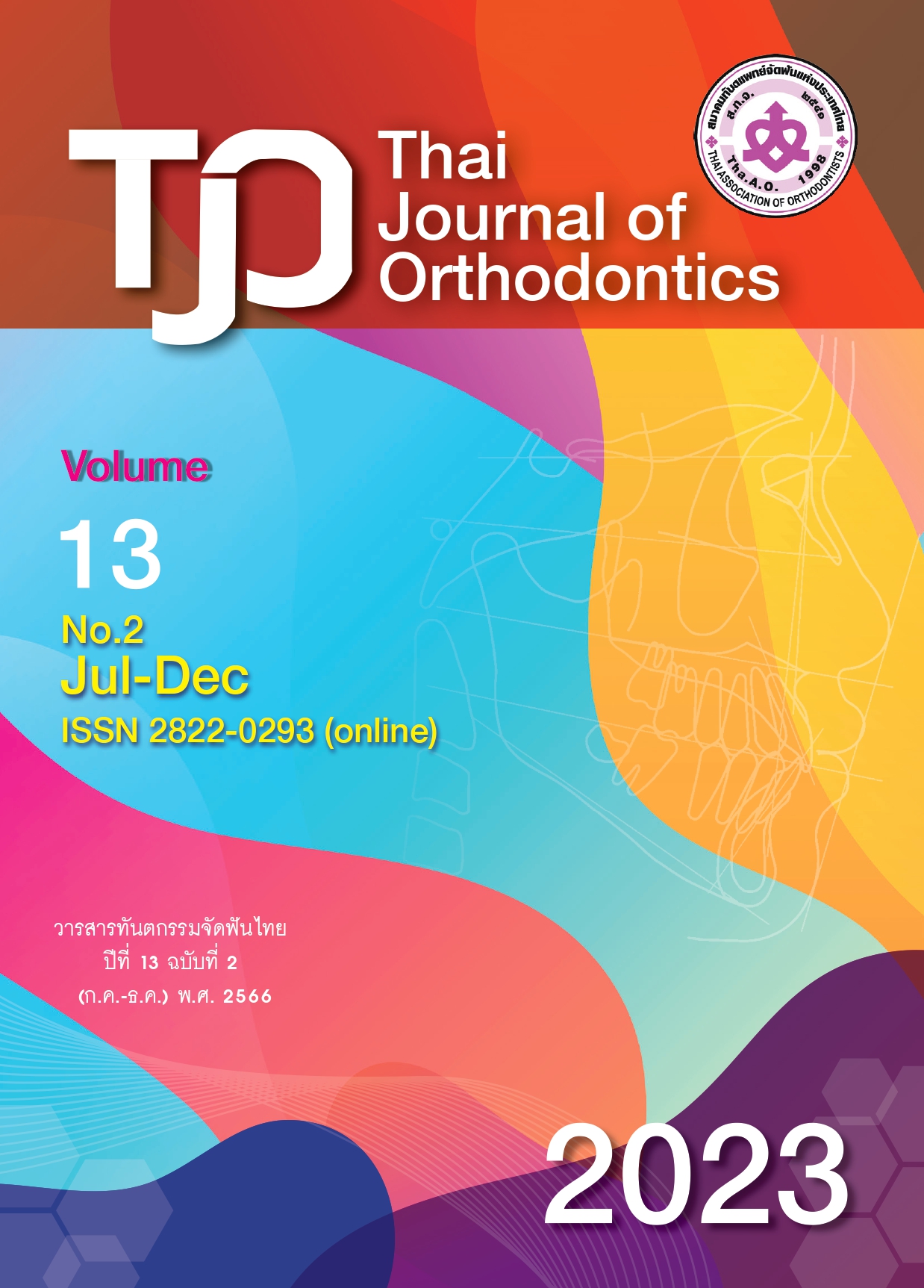Effectiveness of an Activator in Early Treatment of a Class II Retrognathic Mandible : A Case Report
Main Article Content
Abstract
This case report showed a 13 years old Thai boy with a chief complaint of having proclined teeth and spacing around his upper incisors. The main problem was a large overjet due to upper incisor proclination in combination with anterio-posterior skeletal discrepancies by a retruded position of the mandible. The treatment plan included two phases; the first phase was growth modification of the mandible with pre-pubertal growth spurt potential, and the second phase was conventional orthodontic treatment to correct the residual dental problem. The initial treatment was an arch expansion with an upper lateral expansion plate to coordinate the upper and lower arch for four months and to guide the mandible growth with an activator appliance by wearing it at least 12 hours/day for seven months. Progression was evaluated at the end of the first phase. The second phase period was a fixed appliance for twenty months. After treatment, the results showed a satisfactory lateral profile and alignment of teeth where the upper incisor position was corrected and a normal position of the mandible was presented. These outcomes suggest that growth modification works for severe Class II skeletal discrepancies, especially in young patients with future growing potential, as it decreases the severity and enhances normal skeletal growth pattern that decrease the chance of orthognathic surgery.
Article Details

This work is licensed under a Creative Commons Attribution-NonCommercial-NoDerivatives 4.0 International License.
References
Ubilla MW, Mazzini TF, Moreira CT. Orthodontic management of dentofacial discrepancies in skeletal class II patients. Contemp Clin Dent 2018;9(3):474-7.
Proffit W, Sarver D. Treatment in adults in contemporary orthodontics: combined surgical and orthodontic treatment. Mosby, St Louis, MO 2007:689-93.
Hashim HA, Mansoor H, Mohamed MHH. Assessment of skeletal age using hand-wrist radiographs following bjork system. J Int Soc Prev Community Dent 2018;8(6):482-7.
McNamara JA, Jr., Franchi L. The cervical vertebral maturation method: a user’s guide. Angle Orthod 2018;88(2):133-43.
Suresh M, Ratnaditya A, Kattimani VS, Karpe S. One phase versus two phase treatment in mixed dentition: a critical review. J Int Oral Health 2015;7(8):144-7.
Marsico E, Gatto E, Burrascano M, Matarese G, Cordasco G. Effectiveness of orthodontic treatment with functional appliances on mandibular growth in the short term. Am J Orthod Dentofacial Orthop 2011;139(1):24-36.
Hashim HA. Analysis of activator treatment changes. Aust Orthod J 1991;12(2):100-4.
Cozza P, Baccetti T, Franchi L, De Toffol L, McNamara JA, Jr. Mandibular changes produced by functional appliances in class II malocclusion: a systematic review. Am J Orthod Dentofacial Orthop 2006;129(5):599.e1-6.
Tulloch JF, Phillips C, Koch G, Proffit WR. The effect of early intervention on skeletal pattern in class II malocclusion: a randomized clinical trial. Am J Orthod Dentofacial Orthop 1997;111(4):391-400.
Xie J, Huang C, Yin K, Park J, Xu Y. Effects of orthodontic treatment with activator appliance on patients with skeletal class II malocclusion: a systematic review and meta-analysis. Palliat Med 2021;10(12):12319-34.
Sharma NS. Management of a growing skeletal class II patient: a case report. Int J Clin Pediatr Dent 2013;6(1):48-54.
Chintawongvanich J, Thongudomporn U. Arch dimension and tooth size in class I malocclusion patients with anterior crossbite. J Dent Assoc Thai 2013;63(1):31-8.
Suchato W, Chaiwat J. Cephalometric evaluation of the dentofacial complex of Thai adults. J Dent Assoc Thai 1984;34(5):233-43.
Dechkunakron S, Chaiwat J, Sawaengkit P. Thai adult norms in various lateral cephalometric analysis. J Dent Assoc Thai 1994;44(5-6):202-14.
Sorathesn K. Craniofacial norm for Thai in combined orthodontic surgical procedure. J Dent Assoc Thai 1988;38(5):190-201.
Nayak KU, Goyal V, Malviya N. Two-phase treatment of class II malocclusion in young growing patient. Contemp Clin Dent
;2(4):376-80.
Quinzi V, Marchetti E, Guerriero L, Bosco F, Marzo G, Mummolo S. Dentoskeletal class II malocclusion: maxillary molar distalization with no-compliance fixed orthodontic equipment. Dent J (Basel) 2020;8(1):26.
Rongo R, Dianišková S, Spiezia A, Bucci R, Michelotti A, D’Antò V. Class II malocclusion in adult patients: what are the effects of the intermaxillary elastics with clear aligners? A Retrospective Single Center One-Group Longitudinal Study. J Clin Med 2022;11(24):7333.
Moro A, Borges SW, Spada PP, et al. Twenty-year clinical experience with fixed functional appliances. Dental Press J Orthod 2018;23(2):87-109.
Verma S, Mehta F, Alam MK, Parekh HA, Ahmed VKS, Jain C. Class II malocclusion treatment by in-house fabricated, customized fixed functional appliance in growing child. Case Rep Dent 2022:8102482.
Freedman G. Contemporary Esthetic Dentistry. Saint Louis: Mosby; 2012.p.685-718.
Zachrisson BU. Important aspects of long-term stability. J Clin Orthod 1997;31(9):562-83.


